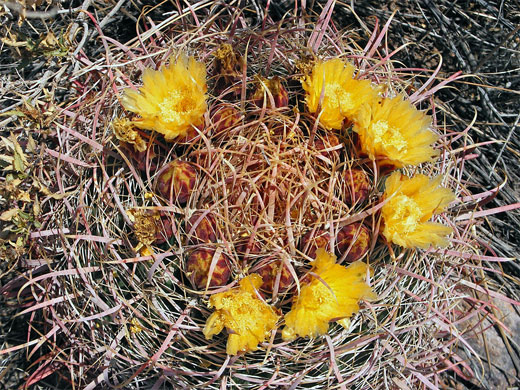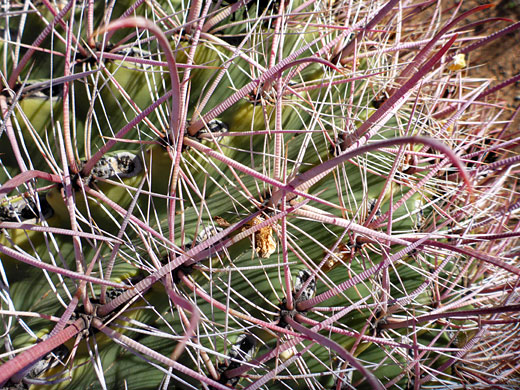Scientific name:
Ferocactus cylindraceus, previously ferocactus acanthodes and ferocactus eastwoodiae
Common name:
California barrel cactus, compass barrel
Range:
California deserts, southeast Nevada, far southwest Utah and low elevation regions of Arizona, including much of the Colorado River corridor
Form:
Cylindrical, up to 8 feet tall, and usually solitary
Habitat:
Varied desert and chaparral environments, up to 4,500 feet
Flowers:
Yellow, sometimes with greenish tints, and reddish on the outside, borne in a neat ring near the apex, appearing in May and June

Distribution map for ferocactus cylindraceus
Ferocactus cylindraceus is by far the most widespread of the giant barrel cacti, and is quite variable in spine color - deep red, whitish, yellow, or intermediate shades, but characterized by a long (up to 5 inches) central spine that points outwards and downwards and is covered by tiny ridges. This spine is curved towards the tip but not strongly hooked. Close by are three more outward-pointing spines, slightly shorter, and eight to 28 smaller, lighter colored radial spines, all contributing to a dense lattice that mostly obscures the green stem and its pronounced ribs, numbering 18 to 31. Flowers are yellow, appearing in spring and early summer, while the fruits are bright yellow.
There are no other barrel cacti for most of its range - California, Nevada, Utah, northwest and southwest Arizona; only in central and south Arizona does ferocactus cylindraceus overlap with the other two large barrels, ferocactus wislizeni and ferocactus emoryi, but the California barrel can be distinguished because the former has fewer and smaller radial spines (and a more strongly hooked central spine), while the latter has no radial spines at all.
Aged California barrel cacti may lean towards the southwest, a trait more often noticed in the similar ferocactus wislizeni. The cactus favours rocky locations, especially the sides of canyons, but is found in a variety of situations. Young plants are spherical and tend to have deep red spines, taking on the familiar upright shape, and lighter spines, after a few decades. The species is also known as ferocactus acanthodes.
There are no other barrel cacti for most of its range - California, Nevada, Utah, northwest and southwest Arizona; only in central and south Arizona does ferocactus cylindraceus overlap with the other two large barrels, ferocactus wislizeni and ferocactus emoryi, but the California barrel can be distinguished because the former has fewer and smaller radial spines (and a more strongly hooked central spine), while the latter has no radial spines at all.
Aged California barrel cacti may lean towards the southwest, a trait more often noticed in the similar ferocactus wislizeni. The cactus favours rocky locations, especially the sides of canyons, but is found in a variety of situations. Young plants are spherical and tend to have deep red spines, taking on the familiar upright shape, and lighter spines, after a few decades. The species is also known as ferocactus acanthodes.
All Contents © Copyright The American Southwest | Comments and Questions | Contribute | Affiliate Marketing Disclosure | Site Map











